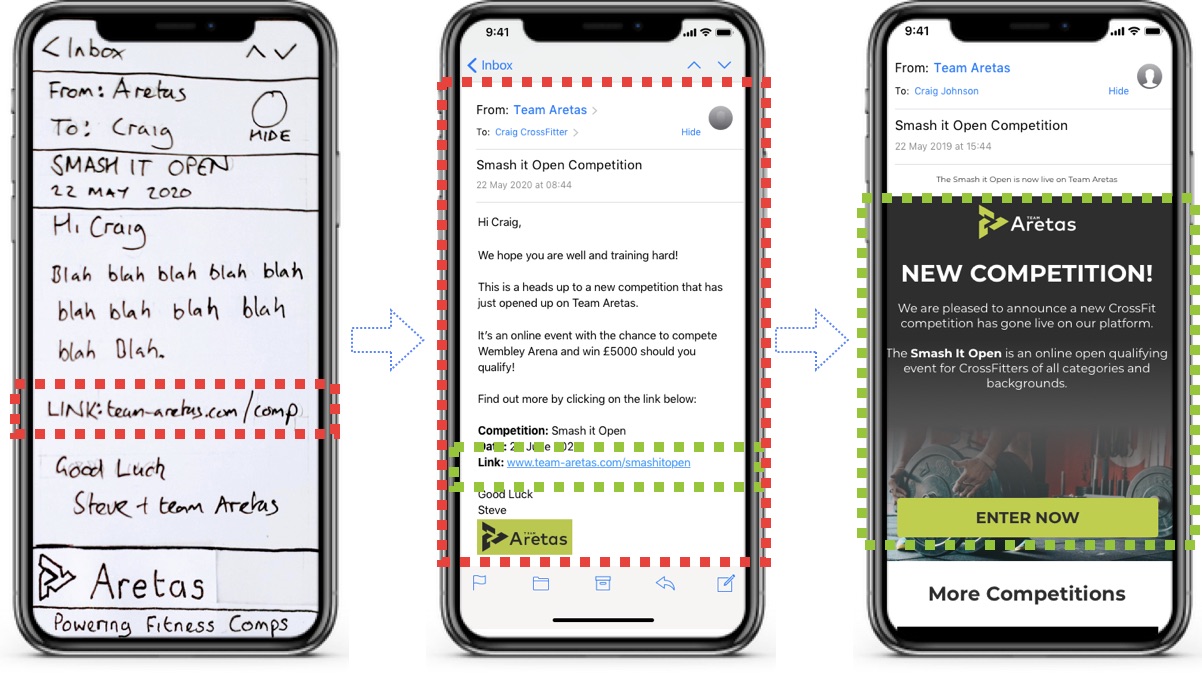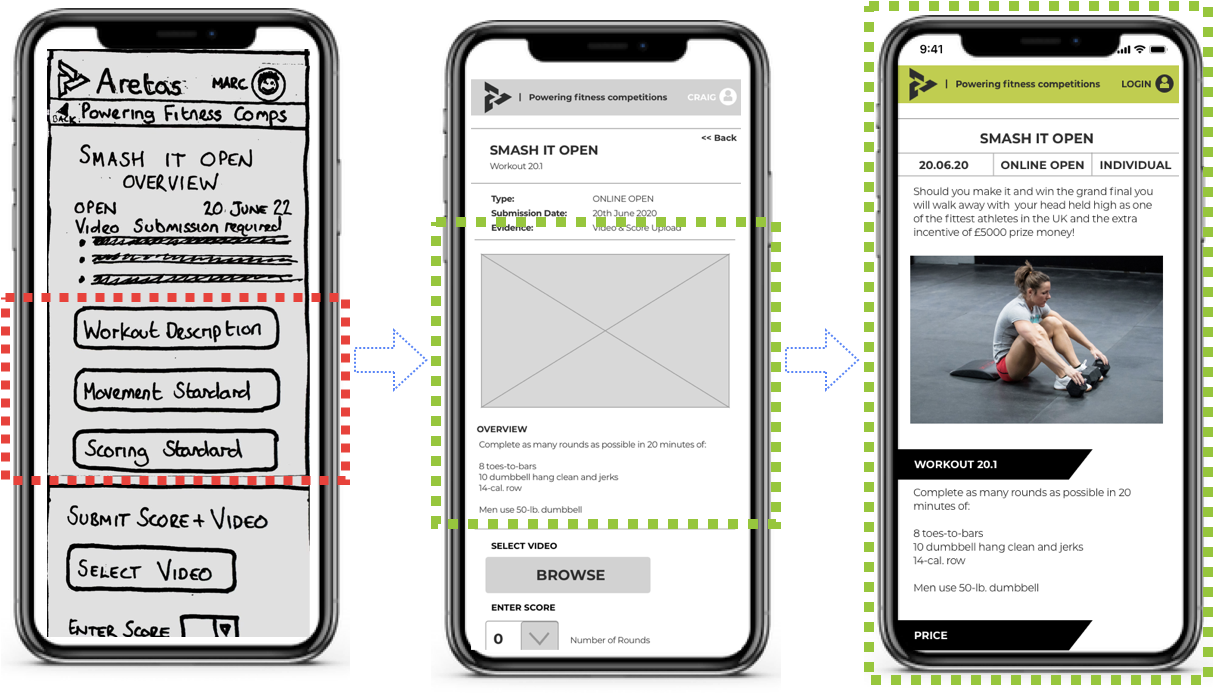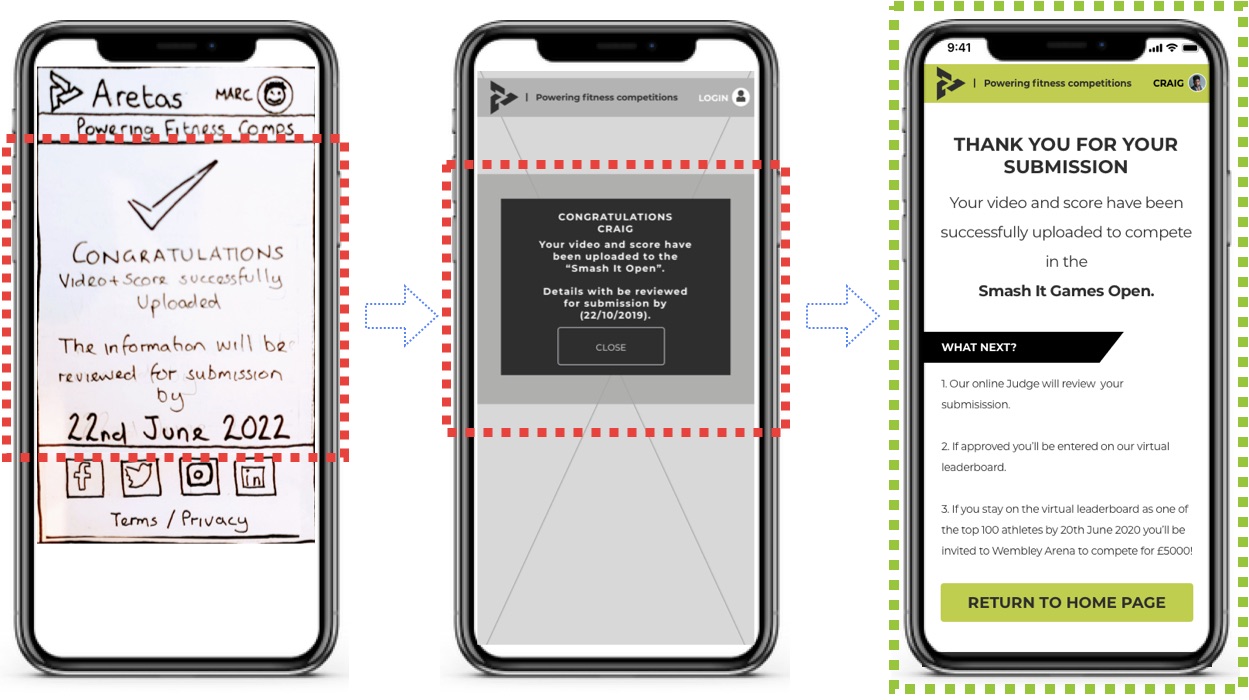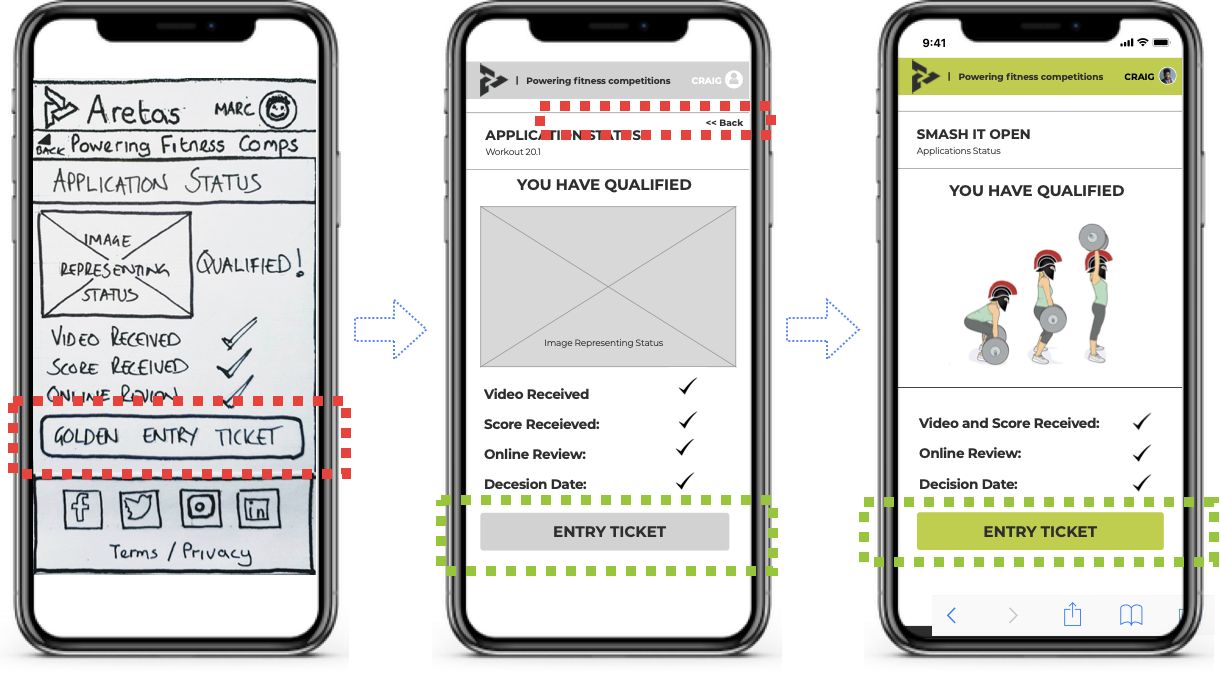Client: Team Aretas
Project Name: TA Competitors Functionality
Brief Summary
Athletes need a way to input their scores and upload a supporting video of a workout to the online, web based, competition management software.
The Team Aretas competition software currently allows for performance scores to be entered by the competition organiser during the event. To continue with our development roadmap and objective of producing functionality that can be re-used for the mobile app, we need to develop the user experience for the athlete to be able to enter their score themselves.
Deliverables
- Research insight & findings concerning competitors, user types and behaviour
- Personas and scenarios
- Experience map/User journeys
- Information Architecture
- Design & usability recommendations for improvement
- User flows and Screen flows
- Product Sketches and wireframes
- High fidelity mock-up
- Prototype of design(s)
- A final presentation to the client which summarises the UX work
Intro
Team Aretas are a sports data company. They are interested in making people fitter through social connections, and are currently working on a competition management software which allows the organiser to run entire fitness competitions. As part of this scores need to be collected.
They wanted to expand their market share, reach, usage and ultimately data by offering a solution for CrossFit Athletes to enter a CrossFit competition through their platform by uploading their own scores.
Athletes needed a way to input their scores and upload a supporting video of a work out to the online, web based, competition management software.
As part of the brief, Team Aretas wanted me to focus on a workflow covering:
- How to notify athlete to complete workout including a mock up of the communication (eg email).
- How the athlete enters their score and supporting video.
- How the competition organiser approves/ amends/ rejects the athlete’s submission.
- How the athlete is notified of the approval/ amendment/ rejection including a mock up of the communication (eg email).
The athlete notification needed to include the workout description, the scoring method, submission date and time and explain the need for a supporting video.
Once the competition organiser approved the athlete’s submission, the score would be fed into the pre-existing leader board where it is ranked.
Approval meant that the competition organiser accepts the number of reps / time taken that the athlete has entered and has verified with their video.
Amend means that the competition organiser has decided to modify the athlete’s score in line with the video. The details of any amendments and the reason for the amendment must be communicated to the athlete.
Reject means that the competition organiser has decided to reject the athlete’s score entirely. The reason for the rejection must be communicated to the athlete.
All of these processes needed full researching, and then screens designed. As there was a focus on a future app, and users were most likely to use a mobile device with the product, it was decided early on to take a mobile first approach with any solution.
Project Goals
- Notify athlete of new competition / workout.
- Enable athlete to enter score & upload video.
- Enable competition organiser approve / amend / reject athletes submission.
- Notify athlete of approval / amendment / rejection of submission.
- Provide functionality that can be reused in App.
Problem
There were three core stakeholders that had to be considered during this project, and they all had differing problems that needed an over arching solution.
Team Aretas needed a way to collect more data and encourage further usage of its platform in order to meet its long term business goals.
The main existing user of the platform, the competition judges, found it onerous to log and upload all competition data in advance and during any competition.
CrossFit athletes who wanted to compete had to find an existing competition and judge to enter through, rather than direct - this discouraged them from entering competitions.
Research
As the brief was particularly unique, and time was limited, the first requirement was a research strategy and understanding what tools could be utilised to conduct a thorough amount of research in a short space of time.
Contextual Analysis A logical place to start is to understand the user in the environment that the product is used, or associated with. In this instance, I visited a CrossFit Gym, or ‘Box’ as it is referred to by CrossFitters.
This environment helped to empathise with the potential users - understanding what it is they do, how they go about it, and how a product can fit in with that routine and lifestyle.
Spending time in the box instantly threw up some concerns around how an athlete could record an entry for submission - mainly around the physical act of recording themselves doing the routine, and small logistical issues like lack of mobile coverage or wifi.
Fortunately CrossFit boxes have trainers on hand to help, and usually you partner up - so the act of recording a submission was possible - however, uploading or live streaming a video upload directly through the product was deemed too challenging by the client, and this functionality was de-scoped.
 Aldgate CrossFit Box
Aldgate CrossFit Box
Competitor Analysis Having that empathy with the user, and understanding the business goals provided a helpful springboard to look at the competition. Namely, were there any solutions that currently existed similar to the current product and future product vision.
After reviewing a number of competitors, it was established that the current closest competitors were Reebok CrossFit and Competitor Corner.
However, both of these products still did not offer a great experience, with only competitions the sites themselves organised being listed and communicated - even then, there was a disjointed process of applying for a competition with potentially 2 or more different sites requiring navigation to find and enter the competition.
Focusing on the business goals and potential functionality when looking at potential competitors threw up more examples with companies such as Strava, VPAR and WODProof all offering something similar.
These applications all provide the ability to capture data, record scores and track performance, and the community aspect is a big factor in their functionality - all points that need to be considered for this project and a future native application.
The User With a good understanding of the product’s aim, the user needs and the competition it was time to dive a bit deeper and extract insights that would ultimately help drive the solution at ideation phase.
I created a screener survey that could be distributed by the client through their own and partner’s channels - in this instance Facebook groups that had been created by the individual CrossFit Box. This provided a good spread of coverage geographically, as well as demographically and also athletes - from those that have never competed in a CrossFit competition, to those that compete regularly.
The surveys response rate provided some interesting insight straight away; 42% of responders had competed in a competition before, with 44% having used a CrossFit app, and 37% having recorded themselves doing a workout.
I then applied criteria to those responders to whittle down who would be best to interview. This criteria focused on those that had competed in a previous competition and had also used a CrossFit app previously.
Using open ended questions related to CrossFit competitions, I tried to extract as much insight as possible in order to help provide direction for any solution. The interviews threw up some notable quotes that helped focus the mind further into the process during the design studio.

“I want to be told of a new competition & be able to find the info quickly & easily”

“If I could record & post videos within the app that would great”

“You don’t even know they’ve looked at your entry”

“I don’t even know if the video has been uploaded”
Affinity Mapping After about 15 face-to-face and phone interviews, there was enough feedback to begin pulling out insights to analyse.
Grouping these insights using the affinity mapping framework resulted in two common themes; one was around competition notifications, specifically when there is a new competition and being notified of the progress of their competition entry.
The other was around the process of submitting their competition entry and video, and what was expected.
Using the Jobs-to-be-done (JTBD) framework. I could then take some of these insights and plot them to a particular statement along with related ‘jobs’ - framing it this way helps with the ideation process when defining a solution.
I then used the How Might We (HMW) framework as a further way of dividing the problem in order to design solutions.
Main Job When I am entering an open CrossFit competition, I want to submit my video and score as efficiently as possible so I can hopefully be accepted on to the competition.
How might we aid the user to submit their video and score as efficiently as possible?
Related Job When I am making the time and effort of entering a CrossFit competition, I want to understand the progress of my application so I can follow my submission status.
How might we keep the athlete informed of the progress of their application?
Solution
With the research throwing out some insights, and allowing me to justify and pinpoint the problem to be solved, I worked with the client to design solutions through a sprint session called a Design Studio. This allowed for rapid prototyping and ideation of screens and features that tied in with the HMW and JTBD statements, and ultimately took us down a path to an overall solution.
The crux of the solution was how a user flow could be designed to make it as simple as possible for athletes to enter a competition, and be notified of the process. By making this process as simple as possible, research indicated more athletes would use the product.
 Team Aretas Mid-Ideation
Team Aretas Mid-Ideation
 Paper Sketches of Solutions
Paper Sketches of Solutions
Design Iterations
Once I had a rough set of prototype screens, with a defined user flow, it was time to test with users to ensure there wasn’t anything that hadn’t been overlooked, and that the process was clear and straightforward.
The below iterations show some of the usability issues thrown up during testing, and progressing from an initial paper prototype, through to a mid-fi screen to the final hi-fidelity design.
 Scenario 1 - Competition Notification
Scenario 1 - Competition Notification
 Scenario 2 - Competition Page
Scenario 2 - Competition Page
 Scenario 2 - Competition Entry
Scenario 2 - Competition Entry
 Scenario 3 - Competition Submission Progress
Scenario 3 - Competition Submission Progress
Demonstration
In the below video demo we have Craig, a CrossFit athlete. The 4 scenarios that are run through are;
- Finds out about competition.
- Enters competition with a video and score submission.
- Logs in to check out the status of his application.
- Receives an email showing his application was successful.
User Flow Video Demo
Final Hi-Fidelity Designs
You can explore the hi-fidelity designs, along with the functionality with the clickable demo found here.
These designs would be delivered to the development team who could then turn them in to code.
Conclusion
Team Aretas’ roadmap was to ultimately consume as much data as possible that could be used for a number of different business models. The best way of achieving this was to allow athletes to submit data themselves - and as the usage volumes grow, so does the data.
This was the first step towards that business goal, and the initial product goals were fulfilled in this project;
- Notify athlete of new competition / workout.
- Enable athlete to enter score & upload video.
- Enable competition organiser approve / amend / reject athletes submission.
- Notify athlete of approval / amendment / rejection of submission.
- Provide functionality that can be reused in App.
In regards to next steps, the two key areas to develop would be the Judge / competition organiser functionality, perform CrossFit environment testing, and ultimately build a native smartphone application - the video below provides a proof of concept for this app.
Proof of Concept App






























